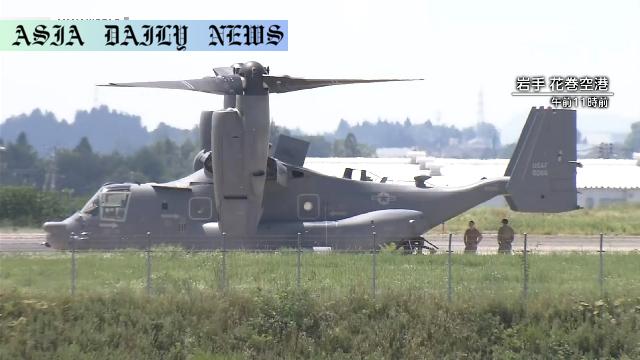Osprey transport aircraft makes emergency landing in northern Japan due to a mechanical issue, officials report.
Osprey transport aircraft made an emergency landing in northern Japan.
Landing occurred due to a mechanical issue at Hanamaki Airport.
Crew members were visible as the aircraft parked on the apron.

Osprey Aircraft: A Sudden Emergency Landing in Japan
A US military Osprey transport aircraft was forced to make an emergency landing at Hanamaki Airport in Iwate Prefecture, northern Japan. Officials reported that the incident happened at approximately 9:50 a.m. Japan Standard Time on Thursday. The tilt-rotor aircraft encountered a sudden mechanical issue, prompting the need for an unplanned but safe landing.
Airport footage captured by NHK cameras revealed the Osprey positioned on the apron after its descent. Despite the unexpected circumstances, the crew members inside the aircraft appeared to be safe and unharmed. Visuals showed them assessing the situation as teams worked to examine the mechanical issue that caused the unplanned stop.
Role and Significance of Osprey Aircraft
The Osprey is a tilt-rotor transport aircraft that combines the functionality of a conventional airplane and the versatility of a helicopter. It is widely utilized by the US military for troop movements, cargo transportation, and various operational duties. Known for its advanced engineering, the Osprey is capable of taking off and landing vertically like a helicopter while achieving high speeds and cruising efficiency during flight.
However, mechanical challenges such as those experienced in this latest incident highlight the complexities and risks of operating such advanced machinery. The quick and decisive actions taken by the crew to land the aircraft safely amidst technical difficulties demonstrate the high level of training and professionalism expected of military personnel.
Response Efforts and Ongoing Investigation
The emergency landing prompted swift action by both airport officials and US military representatives. Technicians and supporting staff have been deployed to the Hanamaki Airport to investigate the root cause of the mechanical failure. Regular checks and maintenance processes are now under scrutiny to ensure the safety of similar aircraft during flight operations.
The Japanese local authorities have cooperated with the US military to manage the situation smoothly, ensuring that no disruptions occurred at the airport’s facilities. As this aircraft remained stationary for inspection, teams coordinated efforts to resume routine airport operations.
Impact on International Operations
This incident underscores the challenges faced by modern aviation and the importance of robust safety protocols. While mechanical breakdowns can occur in even the most advanced machinery, this event serves as a reminder of the need for meticulous checks and maintenance to minimize risks. Moreover, it highlights the importance of international cooperation, especially in regions where military operations interact closely with civilian infrastructure.
Both US military representatives and Japanese authorities are expected to release further details as investigations into the technical failure progress. The findings could provide invaluable insights for future improvements in tilt-rotor aircraft manufacturing and maintenance.



Commentary
Osprey Aircraft: Analyzing the Emergency Landing
The recent emergency landing of a US military Osprey aircraft in northern Japan is a clear demonstration of how vital safety protocols and rapid decision-making are in modern aviation. Emergencies like this remind us of the physical and technical challenges faced by advanced machinery, even when meticulously engineered and maintained. Although the incident could have escalated, the professionalism of the crew ensured a safe resolution.
The Role of Technology and Human Expertise
What sets incidents like these apart is not just the capabilities of the aircraft but the skill and awareness of its operators. The Osprey combines helicopter-like agility with airplane-level speed, making it indispensable in military operations. However, its complexity also means that technical issues must be addressed with the highest precision and expertise, proving the importance of continual training for pilots and ground crews alike.
Strengthening Aviation Collaboration
Japan and the United States have a longstanding alliance, but moments like this test the strength of such partnerships. Coordinated efforts during this emergency serve as an excellent example of international collaboration in mitigating accidents, maintaining safety, and managing aviation disruptions. As details unfold, it will be interesting to observe how both sides use this incident to refine procedures and enhance operational readiness.
Overall, the incident reinforces that while modern aviation technology allows us to achieve extraordinary feats, its efficacy relies equally on the human expertise and international collaborations that support it. Safety must always remain paramount, given the complexity and magnitude of operations involving aircraft like the Osprey.